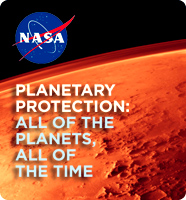-
Abiotic Nitrogen Cycling
Project Investigators: Bishun Khare, David Summers
Other Project Members
Ranor Basa (Undergraduate Student)Summary
This work considers how the chemistry in the atmosphere of Mars (and other “Earth-like” planets) may have affected life, including how prebiotic nitrogen species may have been formed for the origin of life, and how these atmospheres may have been changed. When too much nitrogen is removed from the atmosphere, this can result in a planet with too little atmospheric pressure to support liquid water and life on the surface.
Astrobiology Roadmap Objectives:
- Objective 1.1: Models of formation and evolution of habitable planets
- Objective 1.2: Indirect and direct astronomical observations of extrasolar habitable planets
- Objective 2.1: Mars exploration
- Objective 3.1: Sources of prebiotic materials and catalysts
Project Progress
David Summers & Bishun Khare- Work this year focused on the reduction of NO to ammonia by FeS minerals in aqueous solution. This represents a third nitrogen fixation pathway in addition to the ones identified in previous work. Product yields of ~50% for ammonia were measured. The yield of ammonia formation appears to peak at pH 7 and falls of into acidic or basic conditions. Currently, we are using isotope labeling to identify a gaseous product observed with peaks at 2235, 2100, 1300, and 1270 cm-1 in the IR. We have conducted isotope labeling experiments with 2D2O, H218O, and N18O. The gaseous compound(s) appear to be CNO, (NCO)2, or some related species (a cyanato or isocyanato species). HCNO, HNCO, HOCN, and HONC have been ruled out. The gaseous product is formed in yields that are unaffected by the pH, but which increase as the amount of FeS is increased. We are currently conducting 13C isotope labeling experiments and looking to the 14N isotope fractions of all the reactions we have been studying. These results were presented in an invited paper at the 2008 COSPAR (Committee on Space Research) and at the 2008 Astrobiology Science Conference.
Mission Involvement
Mars missions (orbital and landed)The work will provide data on the chemistry of nitrogen at the surface of Mars, and how such chemistry will affect those surfaces and that characteristics of the surface that might be observed (by such techniques as VNIR/Reflectance, GC/MS, Raman, DTA/GC).Publications
Nna-Mvondo, D., Khare, B., Ishihara, T. & McKay, C.P. (2008). Experimental impact shock chemistry on planetary icy satellites. Icarus, 194:822.
Sekine, Y., Imanaka, H., Matsui, T., Khare, B.N., Bakes, E.L.O., McKay, C.P. & Sugita, S. (2008). The role of organic haze in Titan’s atmospheric chemistry I. Laboratory investigation on heterogeneous reaction of atomic hydrogen with Titan Tholin. Icarus, 194:186-200.
Summers, D., Khare, B. & , B.R. (2008). The Abiotic Fixation of Nitrogen on Terrestrial Planets: Experimental Results and their Implications. 37th COSPAR Scientific Assembly (solicited paper).


- Abiotic Nitrogen Cycling
- Expanding the List of Target Stars for Next Generation SETI Searches
- Formation of Nitrogenated Aromatics in the Interstellar Medium
- Iron, the Oxygen Transition, UV Shielding, and Photosynthesis
- Planetary-Scale Transition from Abiotic to Biotic Nitrogen Cycle
- Surface Processes and Surface-Subsurface Transport on Europa
- The High Lakes Project (HLP)
- Training for Oxygen: Peroxy in Rocks, Early Life and the Evolution of the Atmosphere
- “Are We Alone?” weekly science radio show


